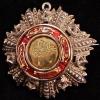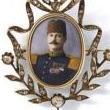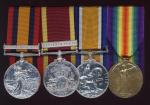-
Posts
20 -
Joined
-
Last visited
Profile Information
-
Gender
Male
-
Location
Australia
-
Interests
paul.rosenzweig@hotmail.com
Recent Profile Visitors
1,931 profile views
Paul Rosenzweig's Achievements
-

Order of Medjidie: Dr Thomas Coutts Morison MRCSE LSA JP
Paul Rosenzweig commented on Paul Rosenzweig's blog entry in Order of Medjidie request
Morison graduated as a doctor from the University of Edinburgh, became a Member of the Royal College of Surgeons of Edinburgh (MRCSE) in 1845, and a Licentiate of the Apothecaries’ Company (LAC) in 1848. -
I think I've got the basic General officer ranks sorted: Brigadier-General / Sahayka Rathi / 1-star: a pair of crossed kukris within a rhododendron wreath. Major-General / Upa Rathi / 2-star: a pair of crossed kukris within a rhododendron wreath, plus a moon. Lieutenant-General / Rathi / 3-star: a pair of crossed kukris within a rhododendron wreath, plus a moon and a sun. General / Maharathi / 4-star: a pair of crossed kukris within a rhododendron wreath, with the addition of a vertical sword over the kukris. Chief General (Chief of the Army Staff) / Pradhan Senapati / 4-star: a pair of crossed kukris within a rhododendron wreath, with a vertical sword over the kukris, plus a moon and a sun. In the post-2006 Nepal Army, a Brigadier-General, a Major-General and a Lieutenant-General wear gorget tabs of red felt with one, two and three gold stars respectively. A General and the Chief of the Army Staff wears gorget tabs of red felt with four gold stars. The insignia with three kukris I’ve never seen before (maybe that’s a joint Service chief?). Also, I have in my collection a rank slide showing a pair of crossed kukris with sword within a wreath, plus a moon – a form of General intermediary between Maharathi and Chief of the Army Staff. Perhaps this is another ‘appointment’ rank for Deputy Chief of the Army Staff, or a joint Service deputy?
-
As for the first one, yes these are the rank slides for an officer holding the rank of General (4-star) who is appointed as Chief of the Army Staff (Pradhan Senapati). In this case, I believe the rank is still at 4-star level but is known as a ‘Chief General’. The distinction is the vertical sword over the crossed kukris, denoting a ‘supreme commander’.
-
There’s an important distinction to make regarding the army in Nepal. During the period when the army was under the direct control of the King of Nepal, it was known as the ‘Royal Nepalese Army’ (RNA). King Birendra was Field Marshal and Commander-in-Chief of the Royal Nepalese Army’. In addition, he was Supreme Commander-in-Chief of the Armed Forces (Atirathi or ‘Grand General’, essentially six-star rank). Following the massacre of King Birendra and other members of the Royal Family on 1 June 2001 and the events which followed, an Act of the Nepalese parliament in 2006 enabled the conversion of the nation from a monarchy to a republic (the ‘Federal Democratic Republic of Nepal’) and curtailed royal power. At this time the national army was redesignated ‘Nepalese Army’ (NA). Since this time, the Supreme Commander-in-Chief (Paramadhipati) of the Nepalese Army is the President of Nepal. I think the insignia shown above are all from the RNA period.
-
I've had a look through the original China and QSA rolls. All RN numbers of this period were 6 numbers. All RM numbers seem to be 4 numbers with a prefix (PO- etc). There are records of RMA members with low digit numbers such as '54'. The rank "Gnr" appears rarely and when it does there's often no number given. I find it hard to believe that someone would take an original named QSA with RofL bar, and an original named China Medal with RofP bar, or particularly a pair named to the same person, and deliberately erase the name and add a new name. Especially to link it to a WW1 pair to a baker. That wouldn't increase the value - but surely if you were going to do that you would use a number/name combination that's realistic...
-
Thanks for the comments. It's unusual because on his enlistment for the AIF in 1916 he claims previous service with the Royal Navy. But all the RN numbers were six digits. '54' - which appears on both the QSA and China Medals - is possible to be a Royal Marines number. I would have thought though, that he would have stated his service as "Royal Marines". He appears on his WW1 record as "William James" but when he died he was buried as "James William" so it's possible he was "J Bourke". Here are images of the naming. His AIF number was 11448. Appreciate your assistance. Paul
-
Are there any experts on HMS Terrible 1900 – and her two ‘relief’ missions? I’m researching a William John Burk who served in the Australian Imperial Force during WW1. His medal group includes the Queen’s South Africa Medal with one clasp ‘RELIEF OF LADYSMITH’ and the China War Medal with one clasp ‘RELIEF OF PEKIN’. On his Australian Imperial Force attestation papers Burk stated he had 3 years’ service with the RN. The two 1900 medals both appear to have been officially renamed in indented capital letters: “54 GUNNER W. J. BURK. H.M.S. TERRIBLE”. To me, this suggests he was a member of the Royal Marines Artillery detachment. There is no-one by that name listed in either medal roll for HMS Terrible. I have seen a list of men from HMS Terrible who were present for both actions but there is no W J Burk listed among them. Are the Royal Marines Artillery detachment listed separately somewhere? I’m thinking that perhaps he adopted the name of William John Burk when he migrated to Australia. I’d appreciate any suggestions. Thanks Paul (Australia) paul.rosenzweig@hotmail.com
-
Thanks for this info. I have a George VI ISM awarded in May 1953 – after the accession of Queen Elizabeth II (on 6 February 1952) but before her coronation (2 June 1953). I guess old stock continued to be used but after the Coronation it would be hard to justify its continued use. Do you know who designed the reverse? Thanks Paul
-

Order of Medjidie: Dr Thomas Coutts Morison MRCSE LSA JP
Paul Rosenzweig commented on Paul Rosenzweig's blog entry in Order of Medjidie request
If anyone is able to help, I've got detailed scan of a stamp on the suspension ring. Thanks Paul -

Thomas Coutts Morison MD
Paul Rosenzweig commented on Nick Hervey's blog entry in Nick Hervey's Blog on Medjidie
Morison’s name cannot be found in the London Gazette being granted permission, nor is he listed in rolls extracted from the London Gazette . Morrison and his fellow surgeons were indeed “actually and entirely employed, beyond Her Majesty’s dominions, in the service of the foreign sovereign by whom the Order is conferred”, but perhaps the Orders had been awarded ‘in the field’ without formal notification through the usual channels to Her Majesty’s Principal Secretary of State for Foreign Affairs[ii]. This might particularly be the case if it was bestowed on behalf of the Sultan by General Zamoyski. Floyd, J B (2000) The Turkish Order of the Medjidie awarded to officers of the British Army and Royal Navy for services in the Crimea. The Orders & Medals Society of America, Medal Notes No.9. California, USA. [ii] “Regulations regarding Foreign Orders and Medals”, Foreign Office, 10 May 1855, published in the London Gazette No.21714 dated 18 May 1855, pp.1916-1917. -

Turkey Order of Medjidie: Dr Thomas Coutts Morison MRCSE LSA JP
Paul Rosenzweig replied to Paul Rosenzweig's topic in Türkiye
Thanks saschaw, that's what I thought. I don't understand how the rosettes come into the picture, but I agree, I think it's 4th Class. -

Turkey Order of Medjidie: Dr Thomas Coutts Morison MRCSE LSA JP
Paul Rosenzweig posted a topic in Türkiye
Dr Thomas Coutts Morison MRCSE LSA JP, son of Sir Alexander Morison, volunteered to serve as a civilian Staff-Surgeon during the Crimean War. He died unmarried in 1863 in Rockhampton in the Colony of Queensland (Australia), and apparently among his possessions when he died was a Crimean War period Order of the Medjidie. I'm looking for some information on this from the people that really know the Medjidie. Morison’s insignia is a silver star comprising seven triple quills with seven small crescents and five-pointed stars between them, the whole measuring 43 mm in diameter (one of the tips has been broken off). Is there any way to distinguish a 4th Class insignia from a 5th Class, just from the star? My impression is that the star is genuine, but there is no entry in the London Gazette because Morison was attached to one of the foreign legions, not the Turkish Contingent. It was probably a field award. Alternately, Morison acquired such a medal and had it engraved as a souvenir of his service.... The gold central disc bears the Sultan’s tughra, the Royal Cipher of the Ottoman Sultan Abdülmecid I, after whom the Order is named. Around this is a gold-bordered circle of red enamel bearing the words in Arabic script for “Devotion”, “Loyalty” and “Truth” and the Islamic year 1268 AH (1852) on four red enamel plaques. There is a suspension loop present, fitted at the rear, but the entire central disc is out of position by 90º clockwise. Is this unusual, or likely to be a fault in the assembly of the original medal? This insignia lacks the typical suspension (a red-enamelled crescent and star suspender with green enamelled edges); this has been removed and the star instead has a horizontal brooch mount on the reverse. The reverse bears a fitted concave silver disc which is engraved to: “Thomas Coutts Morison Staff Surgeon P.M.O. Sultan’s Cossacks”, which I think reflects the writing style of the day. Any comments or feedback from the experts in the field would be greatly appreciated. Paul -

Order of Medjidie: Dr Thomas Coutts Morison MRCSE LSA JP
Paul Rosenzweig posted a blog entry in Order of Medjidie request
Dr Thomas Coutts Morison MRCSE LAC JP, son of Sir Alexander Morison, volunteered to serve as a civilian Staff-Surgeon during the Crimean War. He died unmarried in 1863 in Rockhampton in the Colony of Queensland (Australia), and apparently among his possessions when he died was a Crimean War period Order of the Medjidie. I'm looking for some information on this from the people that really know the Medjidie. Morison’s insignia is a silver star comprising seven triple quills with seven small crescents and five-pointed stars between them, the whole measuring 43 mm in diameter (one of the tips has been broken off). Is there any way to distinguish a 4th Class insignia from a 5th Class, just from the star? The gold central disc bears the Sultan’s tughra, the Royal Cipher of the Ottoman Sultan Abdülmecid I, after whom the Order is named. Around this is a gold-bordered circle of red enamel bearing the words in Arabic script for “Devotion”, “Loyalty” and “Truth” and the Islamic year 1268 AH (1852) on four red enamel plaques. There is a suspension loop present, fitted at the rear, but the entire central disc is out of position by 90º clockwise. Is this unusual, or likely to be a fault in the assembly of the original medal? This insignia lacks the typical suspension (a red-enamelled crescent and star suspender with green enamelled edges); this has been removed and the star instead has a horizontal brooch mount on the reverse. The reverse bears a fitted concave silver disc which is engraved to: “Thomas Coutts Morison Staff Surgeon P.M.O. Sultan’s Coʃsacks”, which I think reflects the writing style of the day. Any comments or feedback would be greatly appreciated. Paul -

Thomas Coutts Morison MD
Paul Rosenzweig commented on Nick Hervey's blog entry in Nick Hervey's Blog on Medjidie
Morison’s insignia is a silver star comprising seven triple quills with seven small crescents and five-pointed stars between them, the whole measuring 43 mm in diameter (one of the tips has been broken off). Is there any way to distinguish a 4th Class insignia from a 5th Class, just from the star? The gold central disc bears the Sultan’s tughra, the Royal Cipher of the Ottoman Sultan Abdülmecid I, after whom the Order is named. Around this is a gold-bordered circle of red enamel bearing the words in Arabic script for “Devotion”, “Loyalty” and “Truth” and the Islamic year 1268 AH (1852) on four red enamel plaques. There is a suspension loop present, fitted at the rear, but the entire central disc is out of position by 90º clockwise. This insignia lacks the typical suspension (a red-enamelled crescent and star suspender with green enamelled edges); this has been removed and the star instead has a horizontal brooch mount on the reverse. The reverse bears a fitted concave silver disc which is engraved in period style to: “Thomas Coutts Morison Staff Surgeon P.M.O. Sultan’s Coʃsacks”, reflecting the writing style of the day. -

Thomas Coutts Morison MD
Paul Rosenzweig commented on Nick Hervey's blog entry in Nick Hervey's Blog on Medjidie
Do you know which vessel T C Morison took to come to Port Philip (Melbourne)? Thanks Paul






